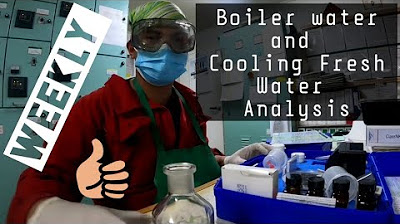Difference between Boiler water, Boiler feedwater & Engine cooling water/Ichem Week 1
Summary
TLDRThis educational video delves into the distinctions between boiler water, boiler feedwater, and engine cooling water. It explains boiler water's role in steam generation within a boiler system, highlighting its circulation through drums and tubes. Boiler feedwater, treated freshwater, is crucial for boiler operations, entering the steam drum to produce steam. Engine cooling water, on the other hand, is used to absorb heat from engines, flowing through circuits to regulate temperature. The video provides visual aids and diagrams to clarify these concepts, making it an informative resource for understanding water's various uses in industrial settings.
Takeaways
- 🔍 Boiler water is a liquid used within a steam generating system and is associated with the boiler drum.
- 💧 Feedwater is treated freshwater that is supplied to the boiler to be converted into steam, serving as the input into the boiler steam drum.
- 🚰 Engine cooling water is used to absorb heat from the engine, maintaining optimal operating temperatures.
- 📍 Boiler water is located inside the boiler drum, while feedwater is located inside the economizer and other components before entering the boiler.
- 🔥 The purpose of boiler water is to generate steam, which is essential for the operation of turbines and other equipment.
- ♻️ Feedwater is heated and converted into steam within the boiler, playing a critical role in the boiler's operation.
- 🌡️ Engine cooling water circulates through the engine, absorbing heat and then passing through a heat exchanger to cool down before re-entering the engine.
- 🚫 The script mentions the importance of distinguishing between boiler water, feedwater, and engine cooling water for proper system operation and maintenance.
- 🛠️ The video script provides a visual guide to where each type of water is located within the system, aiding in understanding their functions.
- ⚙️ The differences between boiler water, feedwater, and engine cooling water are crucial for the efficient functioning of steam boilers and engine cooling systems.
Q & A
What is boiler water?
-Boiler water is the liquid within a steam boiler system, associated with the production of steam and intended for depression purposes.
Where is boiler water located in a boiler system?
-Boiler water is located inside the drum of the boiler, and it is visible through the water level indicators.
What is the purpose of boiler feedwater?
-Boiler feedwater is the water that is fed into the boiler to replace the water that has been converted into steam, ensuring the boiler operation continues.
How does boiler feedwater turn into steam?
-Boiler feedwater is heated within the boiler, and it turns into steam in the steam drum.
What is engine cooling water?
-Engine cooling water is the treated water that circulates through the engine to absorb heat and maintain the engine's temperature within safe operating limits.
How does engine cooling water absorb heat from the engine?
-Engine cooling water absorbs heat as it flows through passages near the engine's hot components, thus preventing overheating.
What is the role of a condenser in the cooling water system?
-The condenser in the cooling water system helps to cool the water by dissipating the heat to the environment, allowing the water to be reused in the system.
How does the temperature of engine cooling water affect its performance?
-The temperature of engine cooling water is critical; if it gets too hot, it can lead to engine damage, while if it's too cold, it can reduce the engine's efficiency.
What is the difference between boiler water and boiler feedwater?
-Boiler water is the water already inside the boiler, while boiler feedwater is the fresh water that is added to the boiler to maintain the water level and produce steam.
Why is it important to monitor the water level in a boiler?
-Monitoring the water level in a boiler is crucial to prevent overheating and potential damage due to dry boiling, as well as to ensure efficient steam production.
How does the cooling water circuit differ from the boiler water circuit?
-The cooling water circuit is designed to absorb and dissipate heat from the engine, while the boiler water circuit is focused on producing steam for various industrial processes.
Outlines

Cette section est réservée aux utilisateurs payants. Améliorez votre compte pour accéder à cette section.
Améliorer maintenantMindmap

Cette section est réservée aux utilisateurs payants. Améliorez votre compte pour accéder à cette section.
Améliorer maintenantKeywords

Cette section est réservée aux utilisateurs payants. Améliorez votre compte pour accéder à cette section.
Améliorer maintenantHighlights

Cette section est réservée aux utilisateurs payants. Améliorez votre compte pour accéder à cette section.
Améliorer maintenantTranscripts

Cette section est réservée aux utilisateurs payants. Améliorez votre compte pour accéder à cette section.
Améliorer maintenantVoir Plus de Vidéos Connexes

CARA KERJA BOILER (With ANIMATION) _ HOW BOILER WORK _ BOILER WORK ANIMATION _ RANKINE CYCLE

Boiler Water and Steam Cycles - Understand the working

Boiler water and Cooling Fresh Water Test Onboard// Unitor Chemicals!

Cara Kerja Mesin Uap

Using Natural Gas to Generate Electricity

Siklus Cold Startup (PLTU)
5.0 / 5 (0 votes)
